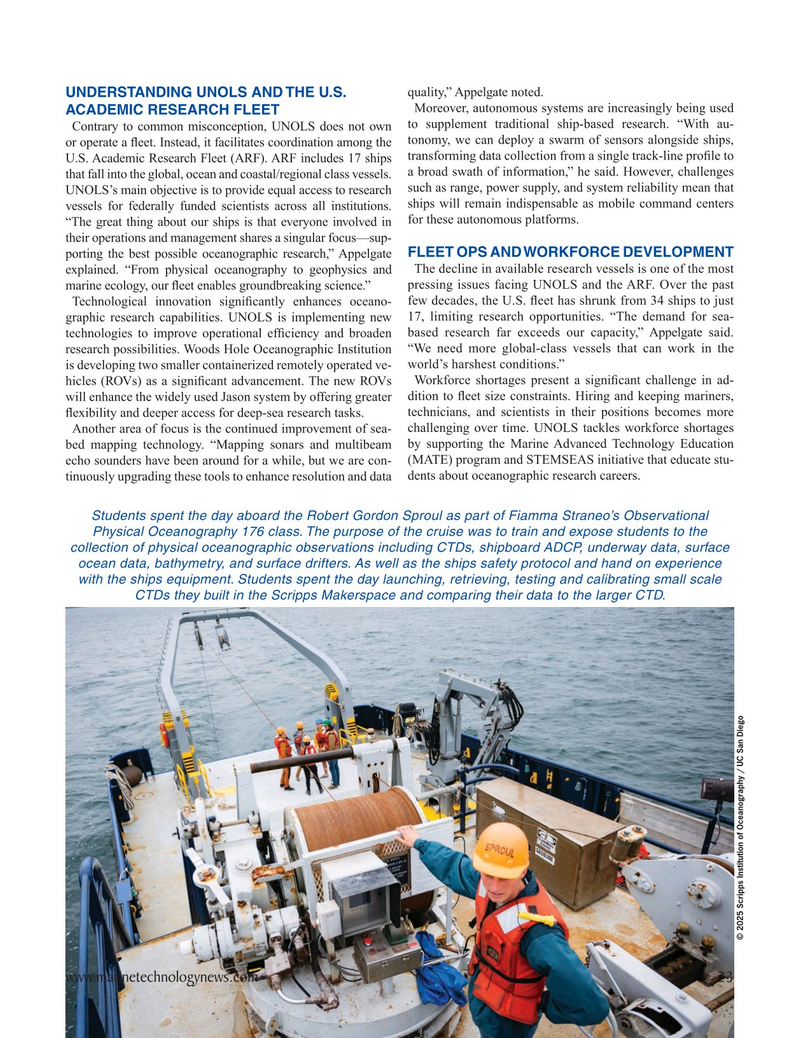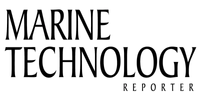
Page 23: of Marine Technology Magazine (March 2025)
Read this page in Pdf, Flash or Html5 edition of March 2025 Marine Technology Magazine
quality,” Appelgate noted.
UNDERSTANDING UNOLS AND THE U.S.
Moreover, autonomous systems are increasingly being used
ACADEMIC RESEARCH FLEET
Contrary to common misconception, UNOLS does not own to supplement traditional ship-based research. “With au- or operate a ? eet. Instead, it facilitates coordination among the tonomy, we can deploy a swarm of sensors alongside ships,
U.S. Academic Research Fleet (ARF). ARF includes 17 ships transforming data collection from a single track-line pro? le to a broad swath of information,” he said. However, challenges that fall into the global, ocean and coastal/regional class vessels.
UNOLS’s main objective is to provide equal access to research such as range, power supply, and system reliability mean that vessels for federally funded scientists across all institutions. ships will remain indispensable as mobile command centers “The great thing about our ships is that everyone involved in for these autonomous platforms.
their operations and management shares a singular focus—sup-
FLEET OPS AND WORKFORCE DEVELOPMENT porting the best possible oceanographic research,” Appelgate explained. “From physical oceanography to geophysics and The decline in available research vessels is one of the most marine ecology, our ? eet enables groundbreaking science.” pressing issues facing UNOLS and the ARF. Over the past
Technological innovation signi? cantly enhances oceano- few decades, the U.S. ? eet has shrunk from 34 ships to just graphic research capabilities. UNOLS is implementing new 17, limiting research opportunities. “The demand for sea- technologies to improve operational ef? ciency and broaden based research far exceeds our capacity,” Appelgate said. research possibilities. Woods Hole Oceanographic Institution “We need more global-class vessels that can work in the is developing two smaller containerized remotely operated ve- world’s harshest conditions.” hicles (ROVs) as a signi? cant advancement. The new ROVs Workforce shortages present a signi? cant challenge in ad- will enhance the widely used Jason system by offering greater dition to ? eet size constraints. Hiring and keeping mariners, ? exibility and deeper access for deep-sea research tasks. technicians, and scientists in their positions becomes more
Another area of focus is the continued improvement of sea- challenging over time. UNOLS tackles workforce shortages bed mapping technology. “Mapping sonars and multibeam by supporting the Marine Advanced Technology Education echo sounders have been around for a while, but we are con- (MATE) program and STEMSEAS initiative that educate stu- tinuously upgrading these tools to enhance resolution and data dents about oceanographic research careers.
Students spent the day aboard the Robert Gordon Sproul as part of Fiamma Straneo’s Observational
Physical Oceanography 176 class. The purpose of the cruise was to train and expose students to the collection of physical oceanographic observations including CTDs, shipboard ADCP, underway data, surface ocean data, bathymetry, and surface drifters. As well as the ships safety protocol and hand on experience with the ships equipment. Students spent the day launching, retrieving, testing and calibrating small scale
CTDs they built in the Scripps Makerspace and comparing their data to the larger CTD.
© 2025 Scripps Institution of Oceanography / UC San Diego www.marinetechnologynews.com 23
MTR #3 (18-33).indd 23 3/13/2025 12:53:34 PM

 22
22

 24
24
